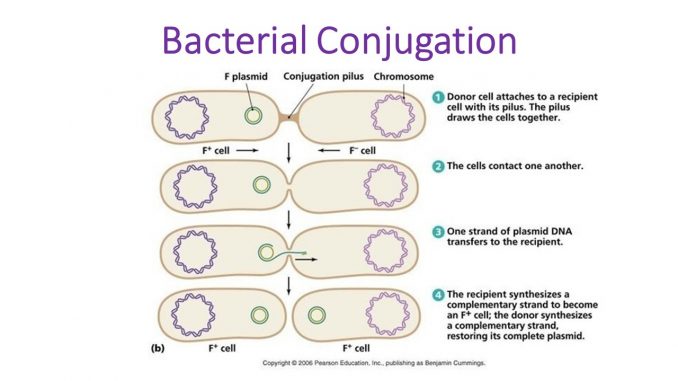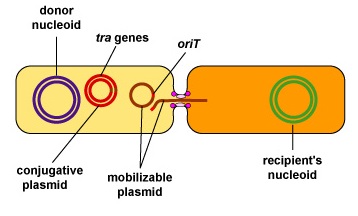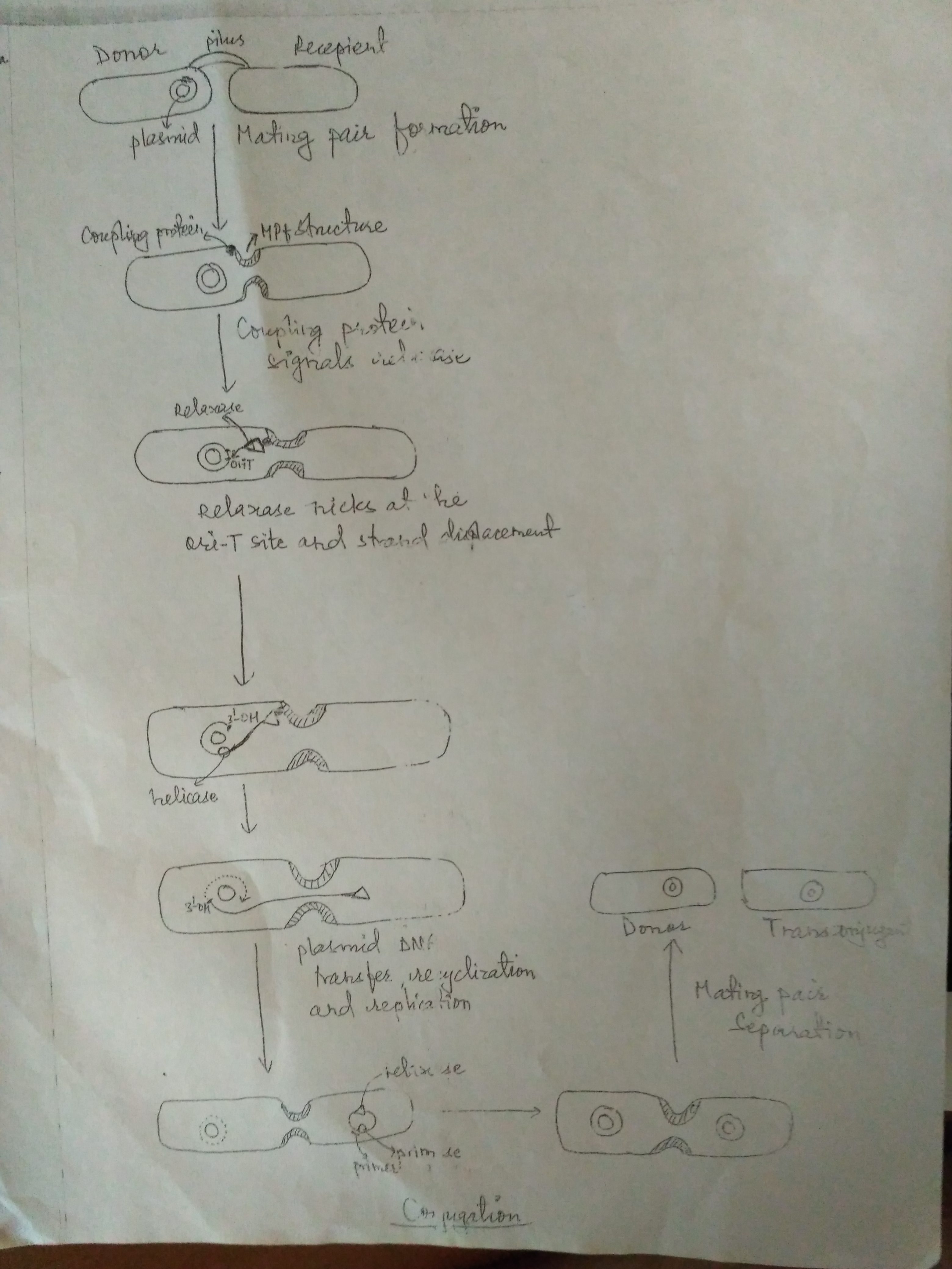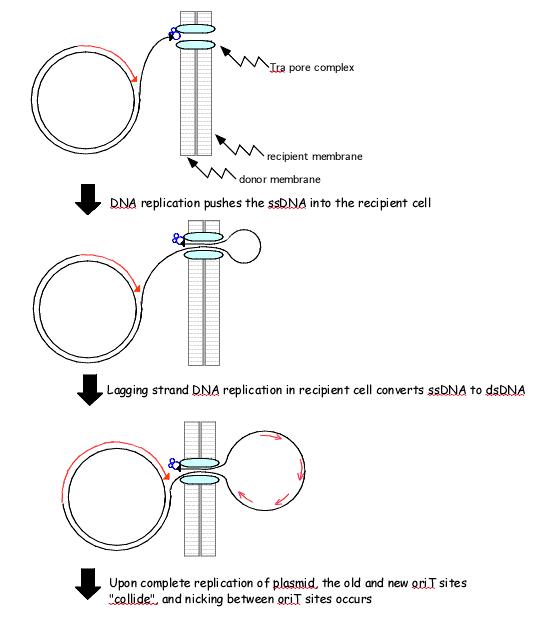
Bacterial Conjugation: steps and mechanism of transfer of plasmid from donor to recipient cell
- Conjugation in bacteria is a process in which plasmids are transferred by themselves alone or along with other DNA element from one cell to another cell through conjugation tube. Conjugation occur by physical contact between cells.
- The cell which transfer plasmid is called donor and the cell which receive the plasmid is called recipient.
- The cell which has received the plasmid from the donor cell is called trans-conjugant.
- The phenomenon of conjugation in bacteria was discovered by laderburg and Tatum in 1946.
Types of Plasmids

1. Self-transmissible (F-plasmid) plasmid:
- These plasmid encodes all the functions necessary for their transfer as well as the transfer of other DNA element and mobilizable plasmid into recipient cell.
- The cell which possess self-transmissible plasmid are called donor cell and other cell which usually don’t possess self-transmissible plasmid are called recipient cell.
- These plasmid contains both Tra gene and Ori T sites
- These plasmid are known as F-factor or F-plasmid or conjugative plasmid
- Present in Pseudomonas, E. coli, Bacillus, streptococcus, Staphylococcus, Streptomyces etc
2. Mobilizable plasmid:
- These plasmid encodes only function for its transfer into recipient cell.
- mobilizer plasmid is not transfer by itself. It requires the help of self-transmissible plasmid for its transfer.
Mechanism of conjugation:
Conjugation is brought about by 2 genes in self transmissible plasmid, namely transacting gene (Tra gene) and Origin of transfer (Ori T) site.
I. Tra gene:
Tra gene consists of 2 components- Dtr and mpf
i. Dtr (DNA transfer and replication) component:
- Dtr component prepare plasmid for transfer.
- It includes components such as= relaxases, relaxosome complex and primase.
Relaxase:
- Relaxase is a site specific endonuclease which acts on plasmid at its OriT site.
- Relaxase also recyclizes the plasmid after it has been transferred to the recipient cell.
- Relaxase is transcribed along with the plasmid into the recipient
Relaxosome complex:
- It consists of group of proteins clustered around the Ori T site
- Relaxosome carries three basic functions-
- It helps relaxase bind to the oriT site and initiates plasmid transfer,
- relaxosome communicates with the coupling protein of Mpf component which signals relaxase when to cut the plasmid at Ori t site,
- Helicase is a component of relaxosome which helps to separate the plasmid DNA strands during displacement and transfer of plasmid.
Primase:
- Primase has no role in replication replication of donor plasmid in donor cell
- The free 3-OH end created at the nick site acts as a primer in donor cell.
- Primase is trnasfered to the recipient cell and synthesizes a primer to complete the replication of another strand of plasmid DNA in recipient cell.
ii. Mpf (Mating pair formation) component:
- Mpf component holds the donor and recipient cell together, forms a channel through which DNA is transferred and signal Dtr component to initiate transfer.
- It has 3 components- pilus, channel and coupling protein
Pilus:
- Pilus holds donor and recipient cell together
- It is 10nm in diameter tubular structure with a central channel projecting out of the cell surface.
- Pili may be structurally long, thin and flexiable and it is encoded by F-plasmid in those cell
- Incompatibility F-plasmid (Inc F) is a long and rigid pili encoded by pKM101 (Inc N)
- Short, thick and rigid plasmid is encoded by RP4 (Inc P)
- Long, thin and flexible pili mediates conjugation in cell in liquid medium
- Short, thick and rigid pili mediates conjugation in cell fixed to solid support (Agar medium)
- Inc I plasmid (col 1BP9) encodes both long, thin, flexible pili and short, thick and rigid pilli, therefore it can mediate conjugation in both liquid and solid media
Channel:
- Channel are also encoded by Tra gene
- Channel mediates the transfer of DNA from donor to recipient cell
Coupling proteins:
- Coupling protein is associated with channel
- It signals the relaxase which then initiates the process of DNA transfer
- Coupling protein determines which protein are to be transported to the recipient cell ( relaxase and primase)
II. Ori T site:
- It is the site where plasmid DNA transfer initiates in donor cell and the site for recyclization in the recipient cell.
- It is the site which is specifically recognized by relaxase.
- Any plasmid that possesses Ori T site can be transferred with the help of self-transmissible plasmid
- Ori T site is a cis-acting site
- A known Ori T site of F-plasmid has around 300 bp and contains inverted repeats and AT rich sites.

Chromosome transfer by plasmid:
Plasmid can also mediate the transfer of chromosome because Ori T site and Tra gene are present in plasmid. For transfer of chromosome, plasmid must be integrated with chromosome. The integrated form of plasmid is known as Hfr or High frequency recombination.
Plasmid can integrate into chromosome through 2 mechanism.
- Recombination: plasmid can recombine with chromosome when plasmid and chromosome share common sequences (homologous sequences). Although the sequences of plasmid are unique to that of chromosome they share homology at certain insertion sequences.
- Transposition: plasmid can insert itself into chromosome by transposons and results in formation of Hfr.
Steps of bacterial conjugation:
Step I: Pilus formation
- Donor cell (F+ cell) produces the sex pilus, which is a structure that projects out of the cell and begins contact with an F– (recipient) cell.
Step II: physical contact between donor cell and recipient cell
- The pilus enables direct contact between the donor and the recipient cells forming conjugation tube
Step III: transfer of F- plasmid
- F-factor opens at replication origin (Ori T site).
- one strand of F-factor is cut down at origin and then 5’end of this strand enters into recipient cell.
Step 4: complementary strand synthesis
- In the last step, the donor cell and the recipient cell, both containing single-stranded DNA of F-plasmid
- A complementary strand is then synthesized in both donor and recipient cell,
- Now the recipient cell also contain a copy of F-plasmid and become a donor cell.

Bacterial Conjugation: steps and mechanism of transfer of plasmid from donor to recipient cell
